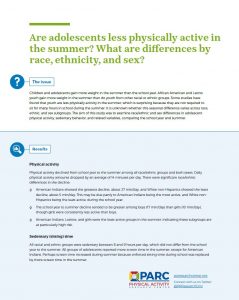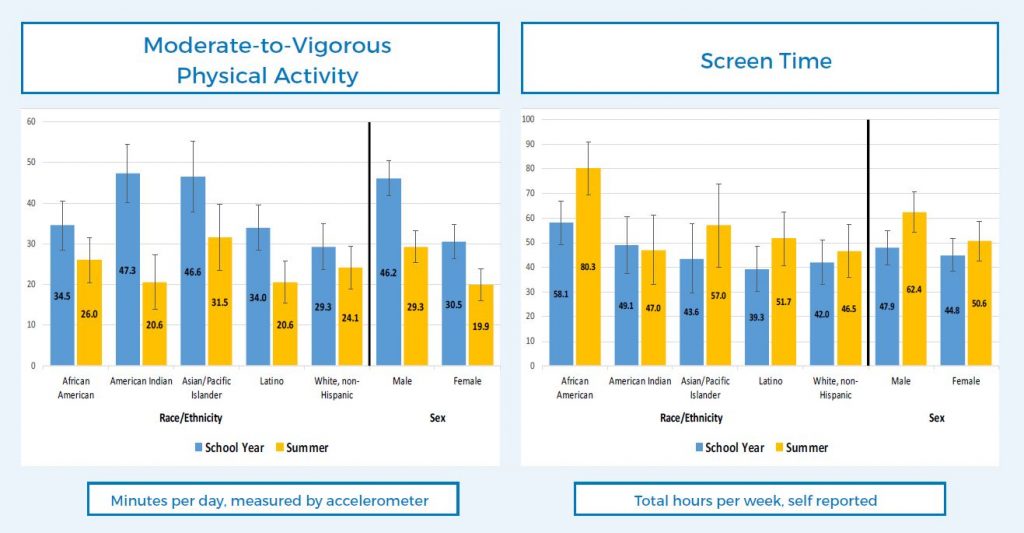Are adolescents less physically active in the summer?
By: James F. Sallis, Terry L. Conway, Kelli L. Cain, Carrie Geremia, Edith Bonilla, Chad Spoon, University of California San Diego
Children and adolescents gain more weight in the summer than the school year. African American and Latino youth gain more weight in the summer than do youth from other racial or ethnic groups. Some studies have found that youth are less physically activity in the summer, which is surprising because they are not required to sit for many hours in school during the summer. It is unknown whether this seasonal difference varies across race, ethnic, and sex subgroups. The aim of this study was to examine race/ethnic and sex differences in adolescent physical activity, sedentary behavior, and related variables, comparing the school year and summer.
Results
Physical activity
Physical activity rates declined from school year to the summer among all race/ethnic groups and both sexes. Daily physical activity amounts dropped by an average of 14 minutes per day. There were significant racial/ethnic differences in the decline:
- American Indians showed the greatest decline, about 27 min/day, and White non-Hispanics showed the least decline, about 5 min/day. This may be due partly to American Indians being the most active, and White non-Hispanics being the least active, during the school year.
- The school year to summer decline tended to be greater among boys (17 min/day) than girls (10 min/day), though girls were consistently less active than boys.
- American Indians, Latinos, and girls were the least active groups in the summer, indicating these subgroups are at particularly high risk.
Sedentary (sitting) time
All racial and ethnic groups were sedentary between 8 and 9 hours per day, which did not differ from the school year to the summer. All groups of adolescents reported more screen time in the summer, except for American Indians. Perhaps screen time increased during summer because enforced sitting time during school was replaced by more screen time in the summer.
Enjoyment of physical activity
All subgroups of adolescents reported less enjoyment of physical activity in the summer. This is a possible explanation of lower physical activity in the summer. Virtually all physical activities are with peers during the school year, so the greater difficulty of organizing activities with peers in summer could reduce enjoyment of summer activities.
What activities do adolescents prefer in the summer?
Walking was the most preferred physical activity across all subgroups and seasons. Exercise (perhaps interpreted as dance exercise) and running were highly rated by all race/ethnic groups, and girls showed strong preferences for water play.
Where do adolescents prefer to be active in the summer?
When asked where they would ideally like to do physical activity, in and around the home were rated highly regardless of season, except for Latinos and White non-Hispanics. Other top choices of places to be active in summer varied across subgroups, although swimming pools were a top choice among Latinos, White non-Hispanics, and girls. Asian/Pacific Islanders and boys preferred indoor recreation facilities. American Indians’ top-rated location was parks outside the neighborhood.
Findings from this lay summary are available in the full article, published in Preventive Medicine:
Sallis, JF, Conway TL, Cain KL, Geremia C, Bonilla E, & Spoon C. Race/ethnic variations in school-year versus summer differences in adolescent physical activity. Preventive Medicine. 2019; 129. https://doi.org/10.1016/j.ypmed.2019.105795.
Suggested Citation for Lay Summary:
Sallis JF, Conway TL, et al. Are Adolescents Less Physically Active in the Summer? What are Differences by Race, Ethnicity, and Sex? A Lay Summary. San Diego, CA: Physical Activity Research Center and University of California San Diego; 2019. Available at: https://paresearchcenter.org/are-adolescents-less-physically-active-in-the-summer/.
This lay summary was made possible with funding from the Physical Activity Research Center. The research that generated the lay summary was led by Drs. James F. Sallis and Terry L. Conway from the University of California San Diego.


